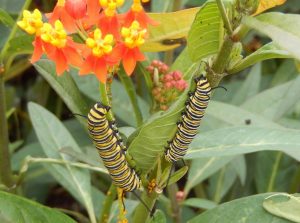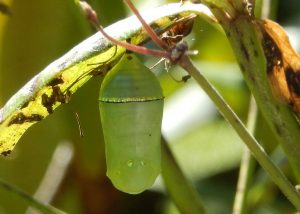Bulletin #7151, Landscaping for Butterflies in Maine
Bulletin #7151, Landscaping for Butterflies in Maine (PDF)
This fact sheet was developed by: Nancy Coverstone, Extension educator, Jim Dill, Extension pest management specialist, and Lois Berg Stack, Extension ornamental horticulture specialist.
For information about UMaine Extension programs and resources, visit extension.umaine.edu.
Find more of our publications and books at extension.umaine.edu/publications/.
Table of Contents
- The Life Cycle of Butterflies
- Common Maine Butterflies
- How to Create Habitat that Entices Butterflies
- “Wild” Places Attract Butterflies
- Native Plants Support Butterflies
- Design Tips for a Successful Butterfly Garden
- Nectar Sources for Butterflies and Moths
- Larval Food Sources
- Further Readings
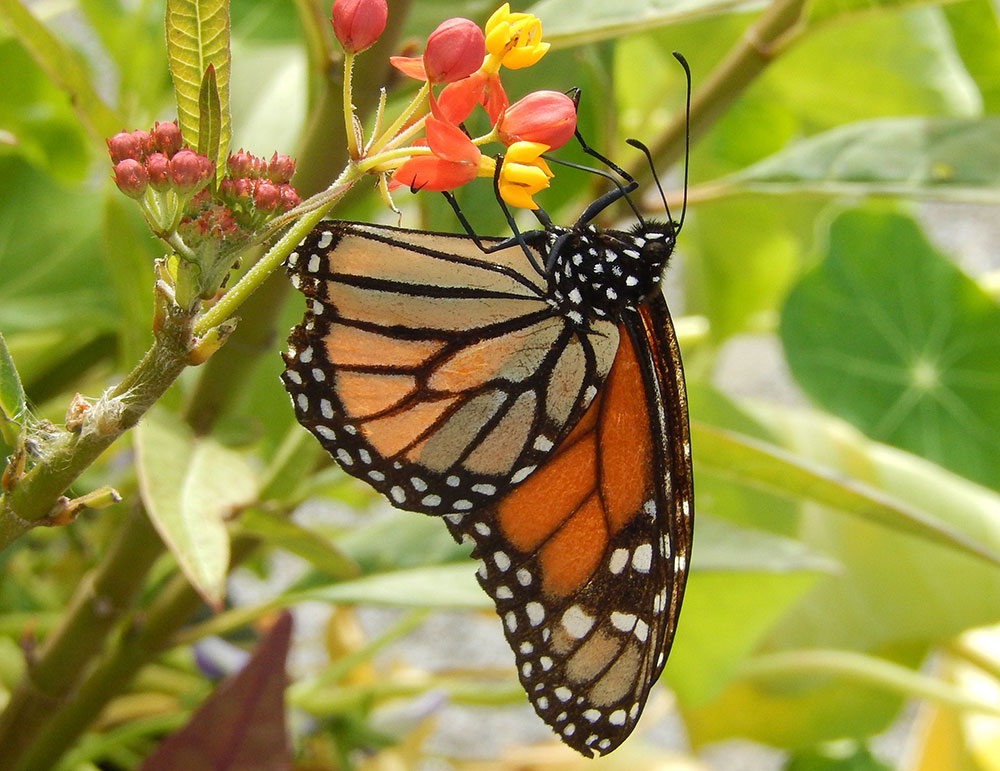
Butterflies are beautiful insects, and they are also an important part of the ecosystem. In their search for nectar, they spread pollen from one flower to another and help ensure seed for new generations of plants. They also recycle nutrients and are prey for many species of birds, spiders and small mammals. Gardening and landscaping can create or enhance habitats for butterflies so they may survive and thrive. Whether your yard is in a city, suburb or rural community, you can make it a haven for butterflies.
Butterflies belong to the insect order Lepidoptera, along with moths and skippers. All species of butterflies in Maine, of which there are more than one hundred, have four wings covered with small scales. The butterfly families in Maine are swallowtails (Papilionidae), whites and sulphurs (Pieridae), gossamer-wings (Lycaenidae), brush-footed butterflies (Nymphalidae), monarchs (Danaidae), and arctics and satyrs (Satyridae), which includes the endangered Katahdin arctic. Skippers (Hesperiidae) have characteristics of both butterflies and moths.
When developing a landscape for butterflies, first consider butterfly species present in your area and their preferred habitats. Then consider plants suited to your climate and your backyard habitat. Assess what your landscape already provides, and add to that. Each butterfly species has a preference or need for a particular habitat type, such as meadow, woods, woodland edges or marshes. Also, some species are specialists, while others are generalists regarding food sources. The habitat preference as well as plants you provide will determine your success in attracting a particular butterfly species. An identification field guide will prove helpful.
The Life Cycle of Butterflies
Butterflies develop by complete metamorphosis, which is characterized by four distinct growth stages: egg, caterpillar, chrysalis and adult. To succeed in enhancing butterfly habitat, it is important to understand their life cycle.
1. The egg. The female butterfly lays her eggs on a plant that will provide food for the larvae, or caterpillars, which hatch from the eggs. Depending on the species, eggs may be laid singly, in small clusters or in one mass. While most species’ eggs hatch within a week of being deposited, some species overwinter in the egg stage, and others stay dormant for up to two years.
2. The larva (caterpillar). The eggs hatch into larvae, which are also called caterpillars, whose purpose is to eat and grow. They have chewing mouth parts to devour leaves of plants.The duration of the caterpillar stage is usually brief, although for some species this stage lasts months. Caterpillars shed their skins several times to allow continued growth. When mature, a caterpillar finds a quiet place to hide. Then it spins silk to attach its hind legs to a firm support, sheds its larval skin and turns into a pupa.
- Monarch caterpillars. Photo by C. Eves-Thomas.
- Monarch chrysalis. Photo by C. Eves-Thomas.
3. The pupa (chrysalis). The pupa, which for butterflies is also called the chrysalis, is the resting stage of development. It may hang under eaves of buildings, on the undersides of leaves, along the stem of a plant, or be found in many other places. This stage lasts 10 to 14 days in most species, but some species overwinter as a chrysalis.
4. The adult. The adult butterfly emerges from the chrysalis. Depending on the species, the butterfly feeds on flower nectar, tree sap, rotting fruit and/or dung. It does this through its proboscis, a straw-like mouthpart that is also used to drink from puddles or other water-saturated areas. Butterflies are active during the day, when males and females court, mate and continue their species. In latitudes farther south, two or three generations may be produced during one season. In Maine, there is time generally for only one generation in the summer season.
Common Maine Butterflies

Eastern Tiger Swallowtail (Papilio glaucus)
Overwinters as a chrysalis.
Habitat: Deciduous broadleaf woods, forest edges, river valleys, parks and suburbs.
Larval food plants: A variety of plants, including wild cherry, basswood, birch, ash, mountain ash, and willow.
Adult food: Flower nectar from a variety of plants, e.g. wild cherry and lilac.
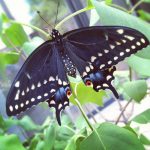
Eastern Black Swallowtail (Papilio polyxenes, subspecies: asterius)
Overwinters as a chrysalis.
Habitat: Open areas including fields, suburbs, marshes, stream banks and roadsides.
Larval food plants: Plants in the parsley family, including Queen Anne’s lace, carrot, celery, parsley and dill.
Adult food: Nectar from flowers, including red clover, milkweed, alfalfa, phlox, Queen Anne’s lace and thistle.
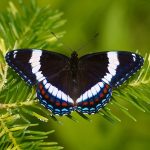
White Admiral (Limenitis arthemis)
Overwinters as a young caterpillar in a rolled-up leaf secured to a twig by silk.
Habitat: Open woodlands, forest edges and roadsides.
Larval food plants: Birch, aspen, poplar, willow, hawthorn, basswood, amelanchier.
Adult food: Rotting fruit, sap, dung, carrion, aphid honeydew, and nectar from various flowers.

Spring Azure (Celastrina ladon)
Overwinters as a chrysalis.
Habitat: Open woodlands, old fields, roadsides, wooded freshwater marshes, forest edges, suburbs and towns.
Larval food plants: A variety of woody shrubs and occasionally herbs including dogwood, New Jersey tea, meadowsweet, viburnum, blueberry, cherry, sumac.
Adult food: Flower nectar from dogbane, privet, New Jersey tea, blackberry, common milkweed, blackberry, dandelion, violet, cherry, cotoneaster, rock cress, winter cress and many others.
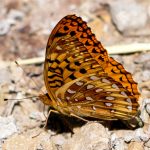
Great Spangled Fritillary (Speyeria cybele)
Overwinters as a newly hatched caterpillar.
Habitat: Open areas, woodlands, moist meadows, roadsides.
Larval food plants: Various species of violet.
Adult food: Flower nectar of thistle and other composites such as Joe-Pye weed, ironweed, black-eyed Susan, and purple coneflower. Also uses cardinal flower, bergamot, red clover, vetch, milkweed.

Red Admiral (Vanessa atalanta)
Usually unable to overwinter in Maine; repopulates each spring by immigrants from more southern areas.
Habitat: Moist woods, yards, parks, marshes, seeps, moist fields, banks of streams.
Larval food plants: Members of the nettle family.
Adult food: Sap flows on trees, fermenting fruit, bird droppings. When these are not available, they will use nectar from flowers such as common milkweed, red clover, aster, goldenrod, gayfeather, and alfalfa.
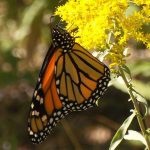
Monarch (Danaus plexippus)
Adults migrate to Mexico or California to overwinter.
Habitat: Open areas, meadows, fields, marshes, roadsides.
Larval food plants: Milkweed.
Adult food: Flower nectar of various species of milkweed and composites such as Joe-Pye weed, aster, thistle, ironweed, gayfeather, cosmos, goldenrod. Also mallow, lantana, buttonbush, dogbane, lilac and various species of mint.
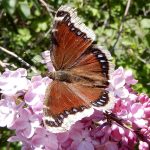
Mourning Cloak (Nymphalis antiopa)
Overwinters as an adult.
Habitat: Woods, openings, parks, and suburbs; especially along banks of rivers and streams.
Larval food plants: Willow, elm, poplar, aspen, cottonwood, birch and hackberry. Older caterpillars wander about and may be found on plants that they do not eat.
Adult food: Tree sap, especially that of oaks. They walk down the trunk to the sap and feed head downward. Also rotting fruit, and only occasionally flower nectar.
How to Create Habitat that Entices Butterflies
As with all living things, butterflies need habitat that provides food, water and cover in an arrangement suited to each species’ needs. For most butterfly species, food, water and cover need to be near one another. Butterflies will thrive in areas that also have full sun, are not windy and are free of insecticides.
- Food for caterpillars. Select plants that provide larval food for caterpillars. Larval food plants, where adult females lay their eggs, are often called host plants. While some species are generalists in their nectar preferences, their caterpillars may feed on only one or two larval foods. Monarch caterpillars eat the leaves of milkweeds. Black swallowtail caterpillars eat the leaves of dill, parsley, carrot and fennel. Painted lady caterpillars eat the leaves of thistles.
- Nectar and other food for butterflies. In addition to sugar and water, nectar provides butterflies nutritional compounds necessary to their life, including amino acids, proteins, enzymes and vitamins. You can provide a steady diet of nectar by planting annual and perennial flowers, shrubs and trees that bloom in succession throughout the season. When local nectar sources are gone, butterflies will search elsewhere.
The timing of the life cycle varies among species. Early-season nectar sources are important for butterflies that overwinter in the adult stage. Late-season nectar sources, particularly aster and goldenrod, are important for species that are in the adult stage at the end of the season. Because late fall flowers have less nectar than those that bloom earlier, fall-feeding butterflies need to visit more flowers to satisfy their nutritional needs. Nectar plants also provide cover for butterflies, and since many are also larval food plants, they offer egg-laying sites.
Choose nectar plants with nectaries accessible to the butterfly’s proboscis. Proboscis length varies among species and determines which flowers any particular species can use for nectar. Smaller butterflies cannot reach the nectar in deep flowers. Flowers with double petals make access to nectar difficult for any size of butterfly. Many double flowers also have less rich nectar than single flowers.
Plants with flower clusters, such as milkweed and phlox, give a place to land and are big enough to support large butterflies. Composite flowers such as gayfeather, goldenrod, zinnia and aster also provide a landing place.
The size of the flower does not influence the quality or quantity of nectar. Many herb plants have small flowers, yet are excellent nectar plants. Some flowers have a nectar guide, a different color in the center of the flower that the butterflies can see, even if we can’t. Nectar guides are very attractive to butterflies.
Plants receiving sun at least six hours each day have more nectar than plants receiving less sunlight. Fertile soil is important for healthy plants, and healthy plants produce more nectar.
Use a diversity of plant species. This will accommodate the flower size and plant species requirements of a number of butterfly species.
Butterflies are near-sighted. Large stands of a particular flower will attract them more than scattered arrangements. Butterflies rely on smell even more than sight in locating nectar plants. Their sense of smell is located in their clubbed antennae. Scent increases a flower’s chance of being pollinated. Once a flower has been pollinated, its energy goes into development of the seed and fruit instead of into production of nectar. It loses the scent that attracts pollinators.
One way to increase the number of flowers as well as to extend the blooming period is to pinch back the stems of nectar plants early in the season. This is most effective with annual flowers. Also, many older varieties of plants have a stronger fragrance than newer hybrids.
Plant shrubs and trees that produce fleshy fruit for butterfly species that require or prefer to feed on overripe fruit. Leave the fallen fruit on the ground for butterflies to eat, although this will also attract bees, hornets and wasps.
- Provide water in the form of a puddle in a sunny area, preferably near the butterfly garden. Containers could be a small trench in the soil lined with plastic, a plastic pail buried in the ground, or a dish or platter. Fill the container with sand, place a few rocks and twigs on the sand to provide landing places within reach of the water, and fill the container with water to the level of the sand.
- Overwintering butterflies need cover. This shelter may already be present in the habitat. Since species overwinter in any of the four developmental stages, adequate cover is essential for survival.
Butterflies overwintering in the adult stage may use the peeling bark on trees, perennial plants and old logs or fences. Old sheds, barns or houses also provide overwintering sites. Butterfly hibernation boxes may attract wasp colonies, and not many of Maine’s butterfly species would use such a box.
The caterpillars of species overwintering in pupal form select a protected location on a permanent structure before they change into a chrysalis. These locations are similar to those needed by overwintering adults.
Herbaceous perennials, shrubs and trees may be used as overwintering sites by butterfly species in the caterpillar or egg stages. Many predators of butterflies, such as birds, spiders and parasitic wasps, are given advantage if there is little cover in which butterflies can hide. Unless there is a specific plant disease problem, leave the leaf litter and dead plants in the garden in the fall, removing them in the spring before new growth begins.
Locate bird feeders and birdbaths away from your butterfly garden. Some birds prey on butterflies in any case, but you don’t want to increase the predation by such proximity.
- Provide gardens in full sun areas. Butterflies warm up to fly and be active. The air temperature must be at least 40 to 60 degrees Fahrenheit. Place perches for sunning in or near the garden, such as flat stones, wooden fence posts and areas of mulch where butterflies can land and spread their wings.
- Plant nectar sources in a site protected from wind to help butterflies fly throughout the garden with less effort. Your house, garage, the neighbor’s buildings, a wood fence or stone wall could serve as windbreaks for the butterfly garden. The windbreak could be shrubs and trees that provide larval food
- Use non-chemical methods of pest management in your yard and gardens. At some stage in their life cycle, all species of butterflies are susceptible to insecticides, which include Bt products. Some of the feeding damage you see on leaves is probably caused by caterpillars. Most leaf damage caused by caterpillar feeding does not pose a significant threat to the plants.
Everything is connected. Managing your habitat for butterflies will also benefit other wildlife and add to your enjoyment. Moths use many of the same larval food and nectar sources as butterflies. Bees, ruby-throated hummingbirds and orioles use nectar from many of the same sources. Some of the plants also provide nest sites, cover and food for birds and mammals. Toward the end of the season, don’t deadhead garden plants, but rather allow seed heads to stand through the winter. Birds eat the seeds and also glean various insect stages from plant stems and leaves. Such winter gardens are very beneficial to wildlife and may reduce next year’s populations of insect pests.
“Wild” Places Attract Butterflies
Some of the best larval food and nectar plants are not ones we normally choose to plant in our gardens. We think of them as weeds. Common milkweed, thistle, and nettle are good examples. If these plants grow wild in an area of your yard, consider this a contribution to your butterfly habitat. The edges of your yard, out-of-the-way corners, and along fences or an old building may be great locations for such plants. They need little care, and, from the perspective of certain species such as monarchs and red admirals, they contribute greatly to the attraction of your yard.
Native Plants Support Butterflies

Native plants are species that either arrived in Maine without human intervention, perhaps thousands of years ago, or originated here. These species of trees, shrubs and wildflowers have evolved over time and developed complex interdependent relationships with other organisms. They are generally better able to meet the needs of regional wildlife species, including butterflies, better adapted to regional growing conditions and easier to maintain than non-native plants. The charts in this fact sheet indicate which plants are native.
Design Tips for a Successful Butterfly Garden
- Choose a garden site in full sun, protected from high winds, and visible from places where you can observe butterfly activity.
- If you need to create wind protection for your site, plant a windbreak of trees and shrubs that provide food and cover for butterflies. These woody plants also add winter interest to the garden.
- Site taller plants in back and smaller plants in front, so you can enjoy watching the butterflies.
- Plant in masses. This is attractive to butterflies.
- Use annuals as summer-long nectar sources, and perennials for single-season nectar sources. If you want to attract a specific species of butterfly, determine what it eats and when the food source is most abundant. Then add the particular nectar plants to your landscape.
- Incorporate some spring-flowering shrubs such as viburnum, blueberry and amelanchier, which produce soft midsummer and fall fruits. As the fruits ripen and rot, they will attract a wider variety of butterflies beyond those that eat nectar.
- Eliminate insecticides from your butterfly garden. Learn to tolerate a certain amount of insect damage to your plants. Some of that damage is caused by caterpillars, which turn into butterflies!
- Add some vegetables and herbs to encourage butterflies to lay eggs in the garden. Eggs hatch into caterpillars, and caterpillars need to eat. Caterpillar forage plants include parsley and ornamental cabbage, which are excellent edging plants for the flower garden; clover, which makes a good “living mulch path;” and carrot and dill, whose fine-textured foliage adds interest to the flower garden.
- Plant some plants for butterflies in containers for flexibility. Window boxes, hanging baskets and other containers allow you to attract butterflies to patios, porches and other highly visible parts of your landscape.
- Don’t deadhead flowers late in the season. Many flowers produce seeds that are favored by birds. Your summer butterfly garden can become a great winter bird garden!
Nectar Sources for Butterflies and Moths
Early-Summer Perennials
- Flowering onions (Allium spp.)
- Pinks and Sweet Williams (Dianthus spp.)
- Dame’s-rocket (Hesperis matronalis)
- Perennial candytuft (Iberis sempervirens)
- Lupine (Lupinus polyphyllus)
- Lychnis (Lychnis spp.)
- Catmint (Nepeta x fassenii)
Mid-summer Perennials
- Hollyhock (Alcea rosea)
- Milkweeds* (some) (Ascelepias spp.)
- Coreopsis (Coreopsis spp.)
- Lavender (Lavandula angustifolia)
- Shasta daisy (Leucanthemum x superbum)
- Beebalm (Monarda didyma)
Late-summer Perennials
- Aster* (some) (Aster spp.)
- Butterfly bush (Buddleia davidii)
- Turtlehead* (Chelone glabra)
- Purple coneflower (Echinacea purpurea)
- Globe thistle (Echinops ritro)
- Joe-Pye weed* (Eupatorium purpureum)
- Gayfeather (Liatris spicata)
- Summer phlox (Phlox paniculata)
- Yellow coneflower (Rudbeckia spp.)
- Showy stonecrop (Hylotelephium spectabile)
- Goldenrod* (some) (Solidago spp.)
Shrub Nectar Sources
- New Jersey tea* (Ceanothus americanus)
- Buttonbush* (Cephalanthus occidentalis)
- Summersweet* (Clethra alnifolia)
- Dogwood* (some) (Cornus spp.)
- Cotoneaster (Cotoneaster spp.)
- Cherry, Flowering almond* (some) (Prunus spp.)
- Azalea, Rhododendron* (some) (Rhododendron spp.)
- Common lilac (Syringa vulgaris)
- Viburnum* (some) (Viburnum spp.)
Shrubs & Trees (ripe fruits attract butterflies)
- Amelanchier, Shadbush* (some) (Amelanchier spp.)
- Crabapple (Malus spp.)
- Cherry, Flowering almond* (some) (Prunus spp.)
- Raspberry, Blackberry* (some) (Rubus spp.)
- Blueberry, Cranberry* (some) (Vaccinium spp.)
- Viburnum* (some) (Viburnum spp.)
Annuals
- Ageratum (Ageratum houstonianum)
- Snapdragon (Antirrhinum majus)
- Bloodflower (Asclepias curassavica)
- Calliopsis (Coreopsis tinctoria)
- Yellow cosmos (Cosmos sulphureus)
- Pink cosmos (Cosmos bipinnatus)
- Blanketflower (Gaillardia pulchella)
- Globe amaranth (Gomphrena spp.)
- Sunflower (Helianthus annuus)
- Heliotrope (Heliotropium arborescens)
- Garden balsam (Impatiens balsamina)
- Lantana (Lantana camara)
- Lobelia (Lobelia erinus)
- Sweet alyssum (Lobularia maritima)
- Flowering tobacco (Nicotiana alata)
- Petunia (Petunia spp.)
- Blue salvia (Salvia farinacea)
- Red salvia (Salvia splendens)
- French marigold (Tagetes patula)
- Mexican sunflower (Tithonia rotundifolia)
- Verbena (Verbena spp.)
- Zinnia (Zinnia spp.)
Larval Food Sources
Herbaceous plants
- Hollyhock (Alcea rosea)
- Wormwood (Artemisia spp.)
- Milkweed, Bloodflower* (some) (Asclepias spp.)
- Aster* (some) (Aster spp.)
- Dill (Anethum graveolens)
- Cabbage, Kale, Broccoli, Brussel sprouts, Kohlrabi, Cauliflower, Mustard, Turnip (Brassica spp.)
- Carrot (Daucus carota)
- Sunflower (Helianthus annuus)
- Stonecrop (Hylotelephium spp., Sedum spp.)
- Mallow (Malva spp.)
- Cabbage (Alfalfa Medicago sativa)
- Parsley (Petroselinum crispum)
- Clover (Trifolium spp.)
- Violet* (some) (Viola spp.)
Trees and shrubs
- Amelanchier, Shadbush* (some) (Amelanchier spp.)
- Birch* (some) (Betula spp.)
- Hornbeam* (Carpinus caroliniana)
- New Jersey Tea* (Ceanothus americanus)
- Hackberry (Celtis occidentalis)
- Dogwood* (some) (Cornus spp.)
- Ash* (some) (Fraxinus spp.)
- Privet (Ligustrum spp.)
- Poplar, Cottonwood* (some) (Populus spp.)
- Cherry, Flowering Almond* (some) (Prunus spp.)
- Oak* (some) (Quercus spp.)
- Sumac* (some) (Rhus spp.)
- Willow* (some) (Salix spp.)
- Common Lilac (Syringa vulgaris)
- Elm* (some) (Ulmus spp.)
- Blueberry, Cranberry* (some) (Vaccinium spp.)
- Viburnum* (some) (iburnum spp.)
*Native plant
Further Readings
Lewis, Alcinda, ed. 1995. Butterfly Gardens: Luring Nature’s Loveliest Pollinators to Your Yard. Brooklyn Botanic Garden Handbook #143. ISBN 0945352883
Tekulsky, M. 1986. The Butterfly Garden: Turning Your Garden, Window Box or Backyard into a Beautiful Home for Butterflies. Harvard Common Press. ISBN 0916782697
Xerxes Society & Smithsonian Institution. 1998. Butterfly Gardening: Creating Summer Magic in Your Garden. Sierra Club Books. ISBN 0871569752
“Butterflies of Maine,” Butterflies of North America, Northern Prairie Wildlife Research Center, USGS. Website address: http://www.npwrc.usgs.gov/resource/distr/lepid/bflyusa/me/toc.htm
(Most butterfly scientific names in this fact sheet are taken from the “Butterflies in Maine” list.)
For more information or to obtain other fact sheets in the Habitats Series, contact your county office of the University of Maine Cooperative Extension.
Information in this publication is provided purely for educational purposes. No responsibility is assumed for any problems associated with the use of products or services mentioned. No endorsement of products or companies is intended, nor is criticism of unnamed products or companies implied.
© 2003
Call 800.287.0274 (in Maine), or 207.581.3188, for information on publications and program offerings from University of Maine Cooperative Extension, or visit extension.umaine.edu.
The University of Maine is an EEO/AA employer, and does not discriminate on the grounds of race, color, religion, sex, sexual orientation, transgender status, gender expression, national origin, citizenship status, age, disability, genetic information or veteran’s status in employment, education, and all other programs and activities. The following person has been designated to handle inquiries regarding non-discrimination policies: Sarah E. Harebo, Director of Equal Opportunity, 101 North Stevens Hall, University of Maine, Orono, ME 04469-5754, 207.581.1226, TTY 711 (Maine Relay System).


